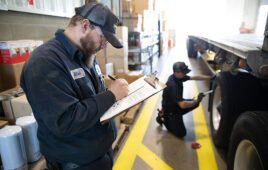 Beer ranks third among the top 10 merchandise categories, behind cigarettes and packaged beverages, according to the National Association of Convenience Stores (NACS) “2016 State of the Industry” Report preliminary data, derived from submissions as of March 31.
Beer ranks third among the top 10 merchandise categories, behind cigarettes and packaged beverages, according to the National Association of Convenience Stores (NACS) “2016 State of the Industry” Report preliminary data, derived from submissions as of March 31.
In addition, the beer category ranks sixth for in-store gross margin contribution at 4.2%.
Moreover, Americans are spending more for better quality beer.
Bonnie Herzog, managing director–beverage, household & personal care, tobacco and c-stores for Wells Fargo Securities LLC, explained that premiumization—an industry term for the willingness by consumers to spend more money on beers that command higher price points—is a key trend among U.S. consumers.
PREMIUM DRIVE
“While sub-premium priced beer dollar sales have declined 5.6% since 2015, premium-priced beer sales have increased 10%,” Herzog said. “Based on an analysis from Nielsen, consumers have been trading up to premium brands, with key reasons including better taste; perceived better quality; consumers wanting to treat themselves; and consumers wanting to try new things.”
Craft and high-end imports have been beneficiaries of this ongoing trend. However, going forward, “while we still expect the premiumization trend to continue, we anticipate this trend to slow slightly as higher gas prices and uncertainty pressure consumers,” Herzog added.
“Beer had a great year in 2016,” noted Meghann Eaton, category manager at VERC Enterprises, a 25-store chain based in Duxbury, Mass. “The biggest piece of the pie was the malted beverage category: Twisted Tea, Mike’s, hard soda, hard seltzer, etc. Almost all brands grew, but the new hard soda and hard seltzer really got traffic to this category. The category grew 40% for us.”
Aside from beer, 2016 showed an uptick in other adult beverages sales in c-stores, including wine and hard cider products.
Eaton cautioned convenience store operators that they need to pay attention to the mainstream craft beers, being careful to rotate in the new flavors suppliers introduce. “The hard seltzers, I think, will do well again this summer. Seltzer, being well established now, and new flavors for 2017, I think will have the biggest impact on beer.”
Two-for deals work very well when it comes to the malted beverage singles, she added.
“Craft and Mexican imports drove the volume here,” said Tim Cote, vice president of marketing for Beaverton, Ore.-based Plaid Pantry, which operates 107 stores. “Beer has gotten so ‘nichey.’ What works in one town likely does not work in another.”
Consumer trends include growth for a variety of styles that craft brewers have popularized, including IPAs, session IPAs, pilsners and sour beers. What excites many consumers in this category, Cote has found, is small, new, local craft brews.
What will fuel growth in 2017, Cote continued, will be products made close to home. Also, cans will continue to be preferred by consumers in every segment. “New SKU’s will be life and death in this category. Fail to launch new SKUs and risk becoming obsolete. The new-item life span is shorter than ever; constant motion is not optional.”
What may hinder growth of the category during the coming months, Cote suggested, is retailers trying to go too high end.
“Some brands are testing how high-priced craft can go. They are finding there is a limit, even in the craft beer center of the universe,” Cote said.
What Makes a Beer Craft?
There are certain industry standards that define a craft beer versus a regular beer.
Two of the most prominent criteria are: a craft product must be less than 25%
owned by a non-craft brewer; and the brewer must make fewer than 6 million barrels of beer per year.




